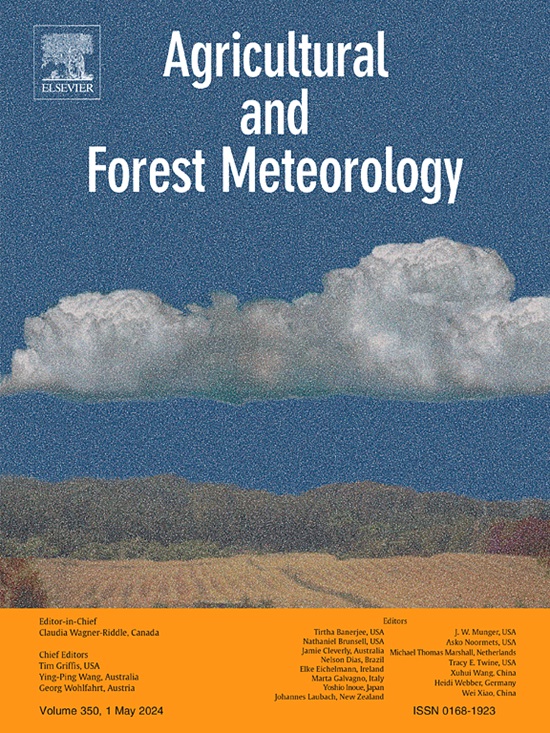Daytime water and CO2 exchange within and above the Amazon rainforest
IF 5.6
1区 农林科学
Q1 AGRONOMY
引用次数: 0
Abstract
We studied the sub-hourly variability of water and CO fluxes within and above the Amazon tropical forest during the dry season. Our aim was to investigate how forest layers contribute to the net ecosystem exchange (NEE) and evapotranspiration (ET) by accounting for the existing vertical profiles of leaf traits and microclimate, and the presence of clouds. To this end, we estimated NEE and ET with a 3-layer land-surface model driven by vertical profiles observed at the Amazon Tall Tower Observatory (ATTO) site during CloudRoots-Amazon22 field campaign. Our analysis focused on a typical “shallow-convective” day, composed of 6 individual days with similar conditions. The observed vertical profiles characterized microclimatic variables (photosynthetic active radiation, air temperature, humidity, CO, wind and turbulence) as well as leaf traits (maximum carboxylation rate, ; maximum electron transport, ; and 13C leaf isotopic composition, ) across three layers that represented the understory, the mid-canopy and the forest top-crown. The modeled NEE and ET were subsequently compared with eddy-covariance (EC) fluxes observed above the canopy.
We found distinctive vertical profiles of leaf traits and microclimate that were maintained during most of the day. In particular, we observed a persistent inversion of temperature within the canopy which hindered air mixing between the top-crown and the lower layers. Modeled NEE and ET fluxes were comparable in magnitude to the EC-measured fluxes, with flux dynamics dominated by the exchange of the top-crown layer. However, differences between observed and modeled NEE emerged during the morning transition (from 7:30 to 9:00 LT), when CO stored within the canopy overnight was released. We conclude that tropical forests exhibit complex, distinctive vertical profiles of microclimate and leaf traits that influence the water and CO vegetation exchange and the transport of air within the canopy.
白天亚马逊雨林内部和上方的水和二氧化碳交换
我们研究了亚马逊热带森林内部和上面的水和CO22通量在旱季的亚小时变化。我们的目的是通过考虑现有的叶片特征和小气候的垂直剖面以及云的存在,研究林层对净生态系统交换(NEE)和蒸散(ET)的贡献。为此,我们在CloudRoots-Amazon22野外活动期间,利用亚马逊高塔天文台(ATTO)站点观测到的垂直剖面驱动的3层陆地表面模型估算了NEE和ET。我们的分析集中在一个典型的“浅对流”日,由6个具有类似条件的单个日组成。观测到的垂直剖面表征了小气候变量(光合有效辐射、气温、湿度、CO22、风和湍流)和叶片性状(最大羧化率、VcmaxVcmax;最大电子输运,JmaxJmax;和13C叶片同位素组成δ13Cpδ13Cp)在林下、冠层中部和林冠上的分布。模拟的NEE和ET随后与冠层上方观测到的涡动协方差(EC)通量进行了比较。我们发现叶片特征和小气候的垂直分布在白天的大部分时间内都保持着显著的变化。特别是,我们观察到冠层内持续的温度逆温,这阻碍了上冠层和下层之间的空气混合。模拟的NEE和ET通量在量级上与ec测量的通量相当,通量动力学由顶冠层的交换主导。然而,观测到的NEE和模拟的NEE之间的差异出现在早上过渡期间(从7:30到9:00 LT),当冠层内储存的CO22在夜间释放时。结果表明,热带森林表现出复杂而独特的小气候垂直剖面和叶片特征,这些特征影响着林冠内水分和CO22的植被交换以及空气的输送。
本文章由计算机程序翻译,如有差异,请以英文原文为准。
求助全文
约1分钟内获得全文
求助全文
来源期刊
CiteScore
10.30
自引率
9.70%
发文量
415
审稿时长
69 days
期刊介绍:
Agricultural and Forest Meteorology is an international journal for the publication of original articles and reviews on the inter-relationship between meteorology, agriculture, forestry, and natural ecosystems. Emphasis is on basic and applied scientific research relevant to practical problems in the field of plant and soil sciences, ecology and biogeochemistry as affected by weather as well as climate variability and change. Theoretical models should be tested against experimental data. Articles must appeal to an international audience. Special issues devoted to single topics are also published.
Typical topics include canopy micrometeorology (e.g. canopy radiation transfer, turbulence near the ground, evapotranspiration, energy balance, fluxes of trace gases), micrometeorological instrumentation (e.g., sensors for trace gases, flux measurement instruments, radiation measurement techniques), aerobiology (e.g. the dispersion of pollen, spores, insects and pesticides), biometeorology (e.g. the effect of weather and climate on plant distribution, crop yield, water-use efficiency, and plant phenology), forest-fire/weather interactions, and feedbacks from vegetation to weather and the climate system.

 求助内容:
求助内容: 应助结果提醒方式:
应助结果提醒方式:


